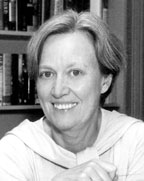
 A
Brilliant Constellation of Cosmologists
A
Brilliant Constellation of Cosmologists
Last year was a stellar year for cosmology, and Princeton scientists in particular had much to celebrate. Decades of theoretical and experimental advances converged, leading scientists to a new view of the universe that is a unified picture, if a startlingly strange one. According to this new view, the universe is expanding at an accelerating rate, with galaxies being pushed away from one another by a mysterious dark energy that eventually will dominate the universe. It appears that this dark energy already constitutes three-quarters of the mass of the universe and nearly all the rest is a mysterious, invisible dark matter. The “ordinary” matter we know— the stuff of rocks, air, water—makes up a mere 4 percent of the cosmos.
In its December 19, 2003 year-in-review issue, Science magazine declared the research advances that support this new view of the universe to be the “Breakthrough of the Year.” The magazine, published by the American Association for the Advancement of Science, cited two experimental programs, one new and the other ongoing, that led the way in confirming and amplifying this model. While both projects are the result of major nationwide, and even international collaborations, both have their origins and continuing leadership in a constellation of cosmologists at Princeton.
The new experimental program cited by Science is the Wilkinson Microwave Anisotropy Probe (WMAP), which also must receive the prize for the most eye-catching results of 2003. Last February, the WMAP satellite produced a detailed map of the “cosmic microwave background,” the remnants of the oldest light in the universe as it emerged from the fireball of the big bang. The satellite, which continues to pour in data, grew out of collaboration between NASA and Princeton with additional contributors at other institutions. NASA announced in February that it had named the satellite after David Wilkinson, the late Princeton professor of physics who conceived the project. Among the faculty in both our physics and astrophysical sciences departments whose ideas contributed to capturing this “baby picture” of the universe are Professors Lyman Page, David Spergel ’82, and Uros Seljak.
The WMAP results meshed with streams of data coming from the second of the experimental programs cited in Science as critical to formulating the new view of the universe, the Sloan Digital Sky Survey (SDSS). This is a ground-based effort to map millions of galaxies across a large swath of the sky. While the survey has been producing data for several years, the SDSS team announced in October a major analysis of the distribution of galaxies, which, among other conclusions, confirmed that the universe is dominated by dark energy. The SDSS project is a collaborative effort of 11 institutions including Princeton, where it began with the ideas and camera designs of Professor James Gunn. Professor Michael Strauss is the project’s scientific spokesperson, and Princeton participants in this collaborative effort include among others Neta Bahcall, Gillian Knapp, Jeremiah Ostriker, and Scott Tremaine.
In another honor for Princeton astrophysics in 2003, NASA announced last December that it had named a major new space telescope after the late Princeton astrophysicist Lyman Spitzer *38, a member of the faculty for nearly 50 years, and founder of the Princeton Plasma Physics Laboratory. Professor Spitzer, the father of space telescopes, first advocated placing observatories above the Earth’s atmosphere in 1946. He and colleagues such as John Bahcall, from Princeton and the Institute for Advanced Study, spent years crisscrossing the country and meeting with government officials to seek—and maintain—support and funding for the project. The Spitzer telescope has already yielded the first of its own breathtaking images of the cosmos and promises to fuel further advances for years to come. That’s good news because according to Professor Spergel, the associate chair of the astrophysical sciences department, in spite of stunning recent advances, there remain “big open questions,” such as:
(1) What is the universe made of? While we have a model that fits all of the data, it’s a very strange one, with 70 percent of the universe made up of dark energy that does not even have “normal” gravitational interactions.
(2) How did the universe begin? While we think we understand the evolution of the universe from the first few minutes of the big bang until the formation of galaxies, we still can not answer the basic question, “what happened during the first moments of the big bang?” Two physics faculty members, Professor Paul Steinhardt on the theoretical side and Suzanne Staggs *93 on the experimental side, have been leading efforts to answer that question.
(3) What determines the basic properties of galaxies? While we now have a theory that predicts the statistical properties of the distribution of galaxies, we do not yet understand the physics that determines the size, shape, and structure of galaxies.
Discoveries made possible by the WMAP, the Sloan Digital Sky Survey,
and the Spitzer telescope will help answer these questions. In addition,
the National Science Foundation just approved a new joint Princeton-Penn-
Rutgers project led by Professor Page. The project envisions the construction
of a 6-meter radio telescope in Chile that will let us “zoom in”
and get a high resolution image of .5 percent of the sky. More evidence
that, for our constellation of Princeton cosmologists, the sky is NOT
the limit. ![]()
